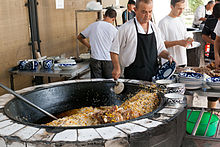pilaf
Pilaf, pilav, plov, pilau or palau is an originally oriental rice dish. It is traditionally made from long-grain rice, onions, broth and possibly meat, fish or vegetables. Pilaf is characterized by a particularly loose and grainy structure. It is not to be confused with biryani .
preparation
Rice is boiled with twice the amount of stock and then steamed in a covered pot. Depending on the type of preparation, other ingredients such as meat, fish, vegetables or nuts and dried fruit are added during the cooking process or when serving.
Etymology and history
According to cultural historians, the original name is Persian پلو/ polow, also pollo - "rice". It may also be a linguistic takeover from India . The cooking technique for pilaf was first introduced in India by Muslims .
The oldest known mention of the pilaf technique is in Arabic books from the 13th century, written in Baghdad and Syria . As ingredients they name meat, legumes and fruits. This technique is not yet found in Arabic recipe collections of the 10th century.
One of the oldest recipes is proven to be qabuli pulaw , originally only with meat and chickpeas , today mostly with almonds and raisins . This variant is now considered a national dish in Afghanistan .
distribution
The rice dish is widespread in many countries and therefore has different spelling variants or names in different languages: Uzbek: Palov / Osh , Kyrgyz: Paloo , Albanian: Pilaf , Armenian: Pilav / փիլավ,, Azerbaijani: Plov , Bosnian: Pilav , Greek : Pilafi / πιλάφι , Persian: Polow, Pollo , Romanian: Pilaf , Russian: Plow / плов , Serbian: Pilav / пилав , Turkish: Pilav . Pilaf was probably spread in European countries by the Ottomans . (Compare also Börek )
Iran
In Persian cuisine , it is particularly desirable if the bottom layer of rice forms a crispy crust in the pot, which is called tah dig (literally the bottom of the pot ). It is considered to be particularly tasty. This preference for baked rice also exists in Armenia and Azerbaijan , but tah dig is not yet mentioned in old Persian cookbooks.
In Iran there are, among others, the following polo courts:
- Adas Polow (lentil rice)
- Albalu Polow (cherry rice)
- Bagali Polow (broad bean rice)
- Gheisi Polow (apricot rice)
- Hawij Polow (carrot rice)
- Lubia Polow (bean rice)
- Sereschk Polow (barberry rice)
- Reschteh Polow (pasta rice)
- Sabsi Polow (herb rice)
- Schirin Polow (sweet rice with chicken)
- Tah Tschin Polow (chicken / duck yogurt rice)
Central Asia

In Central Asia is a dish called Palav , Plow , Palov or Osh an initially stew cooked. At the end of the cooking time, rice is sprinkled over it and covered with a little water, boiled and then steamed. The stew contains meat, onions and carrots as well as other vegetables and sometimes dried fruits. This dish is traditionally cooked by men there and is both an everyday dish and a festive meal. There are also competitions in palav cooking. In Uzbekistan , the dish for weddings is prepared in a huge saucepan by a palav master .
Turkey
In Turkish cuisine , pilaf (spelling: pilaf) is a side dish in addition to vegetables that is served with meat or with beans or chickpeas. This dish (stew with rice) is also a traditional wedding dinner in Turkey, which is served to guests.
In Turkey, especially in the east, bulgur (wheat groats) is often used instead of rice; this is also common in Syria and Armenia and is also called pilaf.
In contrast to other countries, fried beef or lamb pieces or shredded meat ("Etli Pilav": pilaf with meat) and sometimes tomatoes are mixed with the Turkish pilaf rice .
Other countries
In many Islamic countries and India , the most popular types of meat are lamb, mutton and chicken. Pilaf has also been known in Caribbean cuisine for around 200 years , based on recipes from emigrants from India. Unlike in Islamic countries, the dish here often contains pork or ham , Worcestershire sauce , brown sugar and olives or peanuts . In Kenya and Tanzania , pilau is often prepared with beef and with the pilau massala spice mixture, which is influenced by Indian cuisine .
literature
- Alan Davidson: The Oxford Companion to Food , 2nd ed. Oxford 2006, article Pilaf , pp. 606 f.
